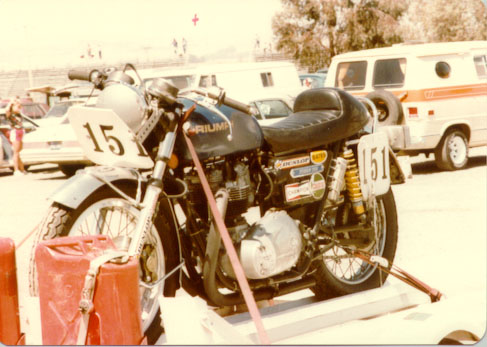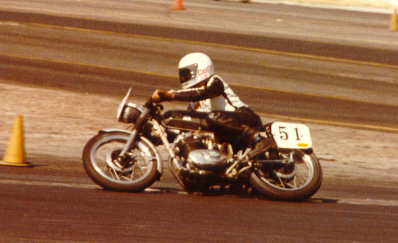| More Production Racing... Since I rode Quinnís "so well", so Chris told me, he offered me the use of the bike for the 1980 AFM season, competing in 250 Modified Production against the likes of RD250s, Can-Ams, X6 Hustlers, as well as other Ducatiís. Entered under the banner of Wheel Works and Bates Leather (my sponsors), I had something to look forward to. Come May we were no doubt behind in our planning, having focused on the 6-hour, we already missed a couple races, but the bike just wasnít ready. With new Michelin PZ2 and PV11ís were fitted, engine and forks serviced, weíd finally be ready. Rules for modified production racing are somewhat simple, although strictly enforced. All machines had to be sold in California during its date of manufacture. Stock frame, forks, handlebar position, fenders, lighting equipment (less tail lamp), brakes, carbs, stroke of the engine, etc., must remain as sold. Our advantage with the Ducati Diana was the use of clipons, a megaphone exhaust, SSI Delorto carb (though only a 29mm), high compression piston, a red/white cam set-up, and. a big valve head, all stock. Our other advantage, or I should say, my advantage, was that I only weighted some 125/130 lbs. Since I lacked any points in the class Iíd have to start from the back, and the little practice Iíd had up to then didnít help matters. In the end, I had a good day, finishing in the top seven. Racing the little Duc instead of the big Triumph is very different, you have to make everything so fluid when riding a little machine with no power (compared to the 750). I had already proved to myself and Quinn I could ride it quickly, though more seat time would be the trick to being consistent. It is very important not to slow these things down, you have to keep the cornering speed up as high as possible... this though was always on my mind when either practicing or racing the 250. I would have four more outings this season on the Ducati (we didnít travel to L.A.), my best result best result being a fourth place against the far-more-modern machines, all of which were of the 2-stroke variety, and fitted with disc brakes. Iím damned if I can remember where I finished in the points, but it was quite reasonable considering the competition. Had we known then what we know now about making Duc singles go, I have no doubt we could have finished further up in both race day and year-end results. For the final race of the year I would bring out the Triumph once again, racing in two events that day. First up was the Duc, followed by the 750. I did okay in both outings. During post-race B>S> with both Chris and my girlfriend, it was remarked that my lap times on the Triumph were a bunch faster than when I rode the twin the previous October during the 4-hour, getting down to nearly 2 minutes flat, which was damn good on a single carb triumph twin running on Dunlop K81Rís. Now I truly understood what my Dad was talking about when I first went road racing on the Trident: that I should start out on a smaller machine to learn the art of carrying speed through the corners, having no horsepower to get me into (or out of) trouble. Iím a believer now. The little Ducati single improved my riding abilities greatly, which allowed me to ride the twin like I rode the Ducati, fast through the corners. |
 |
| Below: Mike Green and the Triumph bite the pavement at Sear Point, turn-6 on the last lap while in 5th place... in AFM 750 Modified Production race. |
 |
| Above: Mike on Quinn's 250 Ducati at Sears Point, AFM 250 Mod Prod.. |